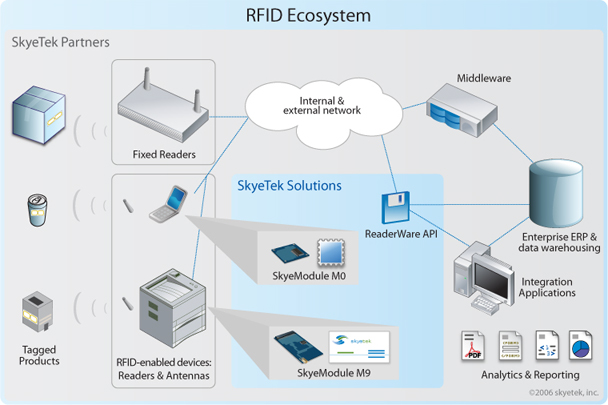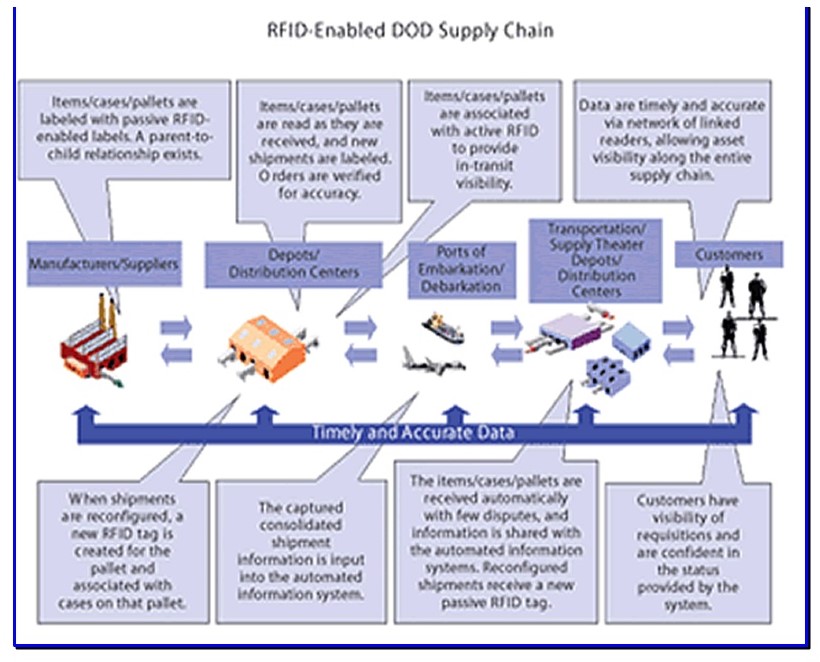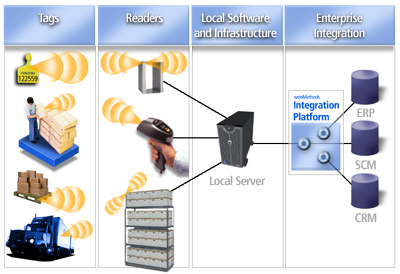RFID Definition
Radio Frequency Identification (RFID) device is an object used for collecting information about a particular product or place minimizing the possible errors at this (Path, 2003). Such devices have become commonplace as hyper-accurate, contact-less, and quite a versatile system for capturing information from any item in which the chip is embedded. The RFID tag or “transponder” essentially consists of:
- An integrated circuit embodying data that may be permanent (an SKU, employee name, or ID number, for instance) or updates dynamically as purchases are made and credits replenished;
- A section “hard-coded” with the modulator-demodulator programming enables the device to accept and respond to radio-wave signals.
- An antenna and, optionally, a battery.
How it works
The components of the RDI devices allow them to transmit information and processing it according to the needs of a definite application. The data that an RFID transmits may be used to identify the place of a particular object, its characteristics (such as color), and even the date of purchase (Association for Automatic Identification and Mobility, 2009). The nearby scanners can send a query signal to a chip-bearing product and read the return signal correctly identifying the item type, the size and variety (also known as “sales keeping unit”), the value stored with the item, and the user to whom an RFID card is assigned.
Schematic of an RFID System That Integrates with Accounting, A.K.A:

Advantages and Disadvantages
Since the antenna can just be a loop of copper wire laid flat around the IC, RFIDs can be miniaturized to a fraction of thumbnail size (Figure 2). Such miniaturization means, among others, that RFID tags can be implanted in currency bills and casino playing chips. In the latter end-use, it becomes possible to detect anyone trying to exit the casino with any number of chips, no matter how well-concealed, as long as the covering material is permeable to radio waves.
Below is an example of an RFID-equipped supply chain with benefits for logistics and forces in the field (Anonymous, 2006).

As far as the disadvantages of RFID are concerned, there are also some. First of all, it is more costly due to its small size and preciseness of data it may give. In addition, “to realize a full potential, RFID requires a system – wide solution, involving all stakeholders, and changes in processes to act on the increased transparency” (Staples, 2005). And finally, the use of this device raises such issues as data ownership and privacy. Nevertheless, all these disadvantages do not make the use of RFID any less frequent.
The relationship between RFID and Accounting
RFID devices facilitate tracking and payment transactions, provide data for financial analysis of credit cards usage, product inventory in the supply and value chains, sales performance, employee attendance and whereabouts, and sales promotion effects. These are all relevant to accounting since such end-uses go towards calculating revenue contribution or operating costs. Other uses include security, health care, and customized advertising or merchandising, but these only indirectly impinge on accounting.
In the aforementioned casino end-use, it is possible for a tableside reader device to instantly count the quantity and total value of pot in a game and thus alert management that the player (or the house) might score a big money win. And this brings us to the key advantage of RFID systems versus bar codes. As may be seen from Figure 3, radio-enabled devices capture data from a short distance away instead of needing to hold each piece or unit of product in front of a laser scanner programmed for bar codes.

This hastens the process of updating inventory or recording sales. Since the data is transmitted to a local server, thence to an integration platform and enterprise resource planning/supply chain management/customer relationship management software suites, accounting information systems can now truly be updated in real-time. The net result is that enterprise management can make vital decisions faster, a critical goal of the finance function.
Reference
Airline-News.Co.UK (2008). BAA and Emirates test new baggage tagging technology. Web.
Anonymous (2006). RFID orders growing. Web.
Association for Automatic Identification and Mobility. (2009). What is RFID? Web.
Path. (2003). Emerging scanning results: radio frequency identification devices. Web.
FoodyLife (2009). RFID system and food traceability. Web.
Rickey’s World (2007). RFID interface with AVR atmega32. Web.
SkyeTek (2006). RFID ecosystem. Web.
Staples. (2005). RFID in Retail. Web.

